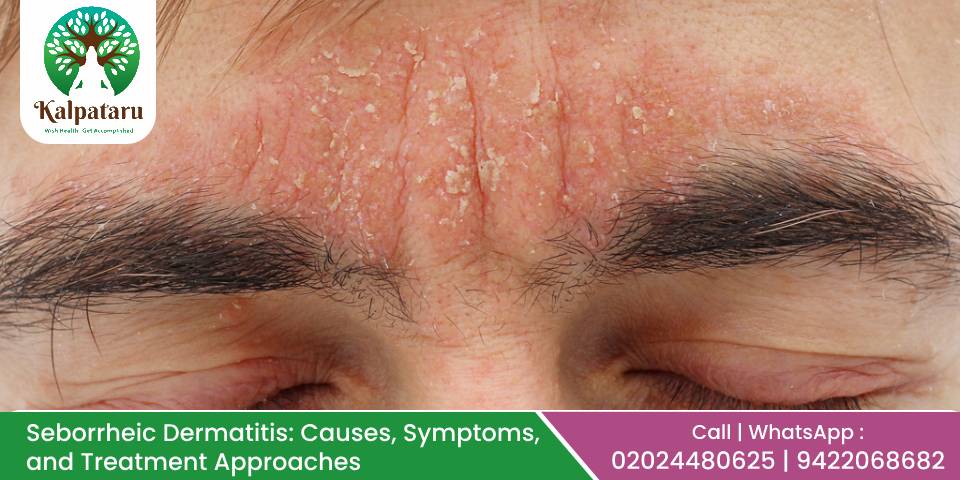Seborrheic dermatitis is a chronic skin condition that primarily affects the scalp but can also extend to areas such as the eyebrows, moustache, beard, and chest. It is often characterized by red, flaky, itchy patches, causing patients to feel embarrassed due to its visibility on the face and other exposed areas. This condition affects the skin’s sebaceous (oil-producing) areas, leading to scaling and dandruff.
Common Symptoms of Seborrheic Dermatitis:
Patients with seborrheic dermatitis often experience:
- Itching: One of the most prominent symptoms, especially when the condition affects the scalp.
- Redness and Flaking: This can occur in multiple areas like the scalp, face, chest, and upper back.
- Scaly Patches: Skin in affected areas can become scaly and greasy, appearing as dandruff.
- Embarrassment and Self-consciousness: Due to visible scaling, patients may feel socially embarrassed and self-conscious, especially when the dermatitis is prominent on the face.
Causes and Contributing Factors:
Seborrheic dermatitis has multiple underlying causes, which include:
- Oily Skin: People with naturally oily skin are more prone to developing this condition.
- Immune System Imbalance: An overactive immune system response may trigger inflammation, leading to dermatitis.
- Lifestyle and Environmental Factors: Stress, changes in climate, dietary variations, and inadequate sleep can exacerbate the condition.
- Yeast/Fungal Infections: Studies suggest that a specific yeast called Malassezia can thrive in oily areas of the skin, leading to an overgrowth and causing inflammation. This is why the condition is often referred to as seborrheic eczema, seborrheic psoriasis, or seborrheic fungal infection.
Conventional Treatments:
In modern medicine, treatment typically involves a combination of topical and oral medications to manage symptoms:
- Antifungal Treatments: Antifungal agents like ketoconazole are commonly used, particularly in shampoos, to reduce fungal overgrowth.
- Anti-inflammatory Medications: To manage inflammation, doctors may prescribe topical corticosteroids for short-term use.
- Oral Antifungals: In severe cases, oral antifungals may be considered to provide systemic relief.
- Steroids (in serious cases): When the condition is persistent and resistant to other treatments, steroids are sometimes prescribed.
Ayurvedic Perspective on Seborrheic Dermatitis:
At Kalpataru Ayurvediya Chikitsalaya™, a holistic approach is taken to treat the root causes of seborrheic dermatitis rather than merely addressing symptoms. The Ayurvedic treatment focuses on lifestyle adjustments, dietary recommendations, and natural remedies to balance the body’s internal state.
- Lifestyle Modifications: Ayurvedic treatment begins with an in-depth analysis of the patient’s lifestyle, diet, stress levels, and sleep patterns. Factors such as poor digestion, irregular sleep, and stress can disrupt the balance of pitta (heat) and kapha (coldness and moisture) in the body, contributing to skin issues.
- Internal Cleansing and Balancing: In Ayurveda, seborrheic dermatitis is linked to imbalances in pitta and kapha doshas. To restore balance, herbal formulations like Manjishthadi Kashaya , Aaragvadhadi kashay are used to detoxify the system and reduce internal inflammation.
- Topical Applications: Ayurvedic ointments made with purified sulfur (Gandhak) are applied to the affected areas to reduce itching and inflammation. Additionally, medicinal pastes created with yogurt mixed with herbs like kachura (spikenard), daruharidra (barberry), and triphala are applied for their cooling and soothing properties.
- Herbal Hair Washes: The clinic prepares specialized hair washes containing triphala, guduchi (tinospora), haridra (turmeric), and jyeshthamadha (licorice). These hair rinses, used warm, help cleanse the scalp, loosen stubborn dandruff, and enhance blood circulation to promote healing.
- Internal Herbal Medications: Ayurvedic formulations, such as various Guggulu compounds and Arogyavardhini Vati, act as internal cleansers, supporting skin health and addressing the underlying causes of seborrheic dermatitis.
For more information and treatment modalities watch our informative video
Panchakarma Therapy for Accelerated Healing:
Panchakarma, a key Ayurvedic detoxification process, is also beneficial for treating seborrheic dermatitis. Some of the recommended Panchakarma therapies include:
- Takra Dhara (Buttermilk Pouring Therapy): This unique Kerala Ayurvedic therapy involves pouring medicated buttermilk on the forehead, which helps reduce stress and balances pitta and kaf dosh, improving immunity and reducing fungal infections in the scalp.
- Virechana (Purgation Therapy): This therapy helps cleanse accumulated toxins and balances pitta and kapha doshas, addressing the root of seborrheic dermatitis.
- Raktamokshana (Bloodletting): Raktamokshana, or bloodletting, is a specialized Ayurvedic treatment aimed at purifying the blood by removing impurities. It is especially beneficial for conditions where intense infections or inflammation are present, such as severe scalp infections. In cases where scalp infections are particularly severe, leech therapy (Jalaukavacharan) is employed to draw out the impure blood. Alternatively, bloodletting may also involve the controlled withdrawal of 100-200 ml of blood from specific veins. This process promotes the formation of purified blood, reducing allergic factors in the body, which in turn accelerates healing and recovery. Raktamokshana helps alleviate symptoms and restore balance in the system, contributing to faster and more effective management of chronic conditions like seborrheic dermatitis.
- Nasya (Nasal Medication): Nasya is a treatment in Ayurveda that is specifically recommended for the organs located above the shoulders. This treatment involves the careful administration of medicinal oils or herbal preparations through the nasal passages. By applying a few drops of these medicated oils into the nose, Nasya therapy helps improve blood circulation to the scalp, boosts immunity, and effectively reduces infections in the affected areas.
Benefits of Ayurvedic Treatment at Kalpataru Ayurvediya Chikitsalaya:
The Ayurvedic approach goes beyond symptom management, addressing the root causes and offering long-term relief. Thousands of patients with seborrheic dermatitis have found lasting improvements by following this personalized Ayurvedic approach, which includes dietary adjustments, lifestyle modifications, and therapeutic herbal treatments.
Conclusion:
Seborrheic dermatitis can be challenging to manage, especially when conventional treatments provide only temporary relief. Ayurveda offers a comprehensive solution that not only targets the symptoms but also enhances overall health by balancing the body’s internal environment. By focusing on lifestyle and diet changes, stress reduction, and herbal treatments, Ayurveda provides a sustainable approach to managing and healing seborrheic dermatitis.

